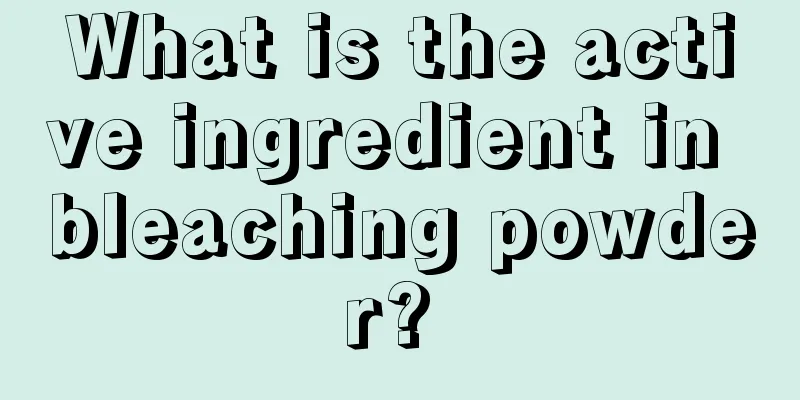What is the active ingredient in bleaching powder?

|
In many industries, bleaching powder is almost indispensable. For example, in the food industry, people use bleaching powder for sterilization and disinfection. This is because ordinary bleaching powder is very cheap and has a good sterilization and disinfection effect. As long as the correct usage method is mastered, there will be no side effects. Therefore, it is widely used in the food industry. So what are the active ingredients of bleaching powder? Active ingredients of bleaching powder: The main components of bleaching powder are calcium hypochlorite [Ca(ClO)2] and calcium chloride, which can be used as a bleaching agent as well as a disinfectant. The active ingredient in bleaching powder is [Ca(ClO)2], and the principle of bleaching is: Ca(ClO)2 reacts in the air. Bleaching powder is a mixture of calcium hydroxide, calcium chloride and calcium hypochlorite. Its main component is calcium hypochlorite [Ca(ClO)2], and its effective chlorine content is 30%-38%. Bleaching powder is white or off-white powder or granules with a noticeable chlorine odor. It is very unstable, highly hygroscopic, and easily decomposed by light, heat, water, and ethanol. Bleaching powder dissolves in water, and its aqueous solution can turn litmus paper blue, which then gradually fades and turns white. When it comes into contact with carbon dioxide in the air, it can release hypochlorous acid, and when it comes into contact with dilute hydrochloric acid, it will produce a large amount of chlorine gas. The main component of bleaching powder is calcium hypochlorite, which is a white powder with a chlorine-like odor. It is used for bleaching cotton, linen, pulp, silk fiber fabrics, sterilizing and disinfecting drinking water, swimming pools, etc., purifying acetylene, etc.! Firefighting measures Hazardous properties: Strong oxidizing agent. Contact with water or humid air may cause combustion and explosion. Mixing with alkaline substances can cause explosion. Contact with organic matter may cause fire hazard. When exposed to heat, acid or sunlight, it will decompose and release highly toxic chlorine gas. Hazardous combustion products: chlorides, calcium oxide. Fire extinguishing method: Firefighters must wear gas masks and full-body fire suits and extinguish fires in the upwind direction. Fire extinguishing agent: direct water, mist water, sand. Leakage treatment Emergency treatment: Isolate the leaked contaminated area and restrict entry and exit. It is recommended that emergency response personnel wear dust masks (full-face masks) and protective clothing. Avoid direct contact with leaking material. Do not allow the leaked material to come into contact with reducing agents, organic matter, flammable materials or metal powders. Small leakage: Avoid creating dust, collect the leak into a dry, clean, covered container with a clean shovel and transfer to a safe place. Large leak: Cover with plastic sheet or canvas. It is then collected for recycling or transported to a waste treatment site for disposal. |
>>: What are the functions of bleaching powder?
Recommend
Is drinking soup in the morning good for your health?
Everyone needs to eat a lot of food every day to ...
Do lemons contain vitamin C?
Vitamin C is one of the essential vitamins for th...
Why does ovarian teratoma grow
Ovarian teratoma is caused by bad living habits, ...
Differential diagnosis of prostate cancer
Prostate cancer is a malignant disease that shoul...
Can aloe vera gel grow eyelashes?
Everyone is very familiar with aloe vera. Many pe...
Are women who are too depressed more likely to develop breast cancer? Five ways to check for breast cancer in women
Physical health is not only related to life and d...
How long can a 70-year-old man live with mid-term conservative treatment of esophageal cancer
When conservative treatment is chosen for mid-ter...
What is the ranking of acid-reducing teas?
Gout is a very common disease in normal times. Go...
How much does it cost to treat nasopharyngeal carcinoma
How much does it cost to treat nasopharyngeal can...
Can papillary thyroid carcinoma heal itself? How to treat papillary thyroid carcinoma
Papillary thyroid cancer cannot heal on its own. ...
Can I eat oranges on an empty stomach?
Fruits occupy an important position in our daily ...
White hair suddenly grows on my face
Some people may find that white hair suddenly gro...
The difference between donating platelets and donating blood
Our unit and work organization often organize blo...
Pathology and pathological classification of renal cancer
Kidney cancer is a relatively serious cancer. If ...
Fibroids are closely related to genes and heredity
Does fibroid tumor have an important relationship...









